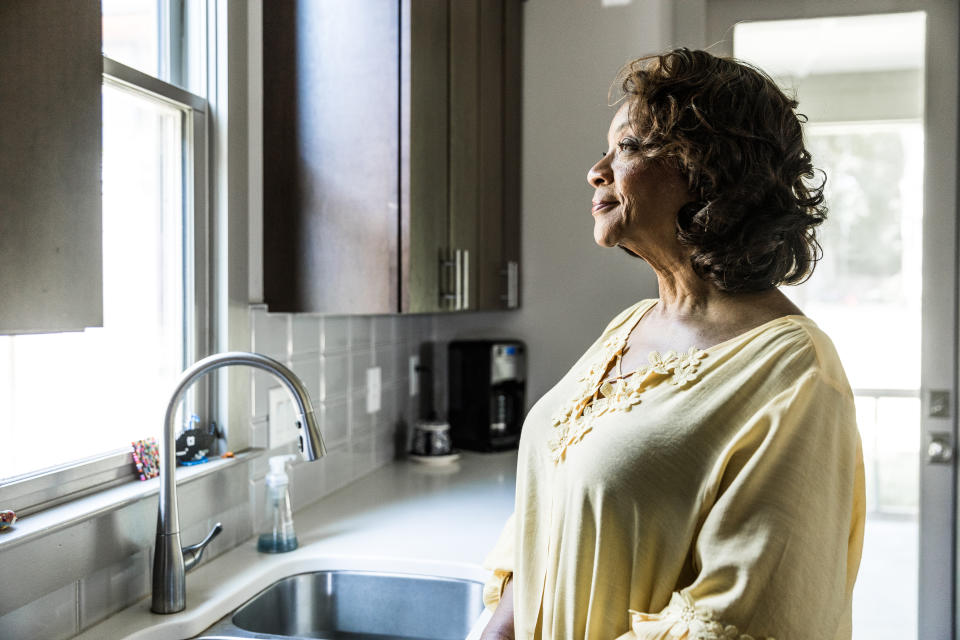Pandemic could exacerbate longstanding obstacles to homeownership for Black Americans
Homeownership — an emblem of the American dream and a pathway to building wealth — continues to remain out of reach for many Black Americans. The coronavirus pandemic could make that worse.
The homeownership rate for all Americans in the U.S. was 65.3% in the first quarter, according to the Census Bureau. But the overall rate masks the disparity between white and Black homeowners. About 74% of white Americans own a home, whereas only 44% of Black Americans do.
Read more: What is a mortgage? Here are the basics
As job losses for Black workers outpaces the rate for whites following the COVID-19 outbreak and subsequent state shutdowns, the gap may widen more, experts fear.
“There’s no doubt this divide will worsen especially if you look at the credit underwriting side,” said Tendayi Kapfidze, chief economist at Lending Tree. “Now that the Black employment rate is worse relative to white employment because of the pandemic, this is going to translate to more difficulty for Black homeowners to get a home.”
‘It’s been with us since the 1900s’

The 2020 recession could be the second economic crisis in a row — within just over a decade of each other — that disproportionately hurts Blacks more than whites seeking homeownership.
Both Black Americans and white Americans hit their highest ownership rates in 2004, several years before the housing market peaked. Since then, white Americans are 2.5 percentage points off that high, while Blacks are more than double that, 5.7 percentage points from their record rate.
This is largely because of the Great Recession’s particular toll on Black homeowners.
Read more: How to find affordable homes to buy
“If you think about the housing bubble and how through predatory lenders too many people were receiving mortgages they couldn’t maintain, people of color were much more targeted,” said Skyler Olsen, senior principal economist at Zillow, a real estate listing site. “Those were the people who felt the foreclosure experience.”
A study last year from Zillow.com found that foreclosures in black communities were two times as likely than in white communities during the housing bust in the Great Recession, a setback that Blacks are still trying to recover from.
But even before the 2008-09 recession, Blacks faced historical obstacles.
“This is a long term divide,” said Olsen. “It’s been with us since the 1900s.”

One of the perpetrators of the housing divide remains redlining, which stems from the Jim Crow era. The practice of denying mortgages for minority dominant neighborhoods was banned by the Fair Housing Act of 1968, but continues to have lasting impressions on Black communities today.
A 2018 study by Zillow found that home values that were redlined years ago have grown by 203.1%, but those in non redlined areas grew by 230.8%.
“I think to close the gap you have to ask what created the gap and this gap is entirely a function of government policy started centuries ago,” Kapfidze said. “If you look at the period following the Great Depression, there was an increase in white ownership, [but] not an increase in Black ownership due to the GI Bill.”
Read more: Buying your first home: What you need to know
The Servicemen’s Readjustment Act, otherwise known as the GI Bill signed by President Roosevelt in 1944, stated that all World War II veterans would have guaranteed mortgages. But the act didn’t include provisions to prevent local banks from discriminating against Black Americans.
“If you think about the compounding of wealth over time,” Kapfidze said. “All that adds up and gets us to where we are today.”
‘Credit remains tight’
Fast forward to 2020, when a pandemic and economic shock has left at least 20.5 million Americans depending on unemployment benefits. Concerned about the jobless rate and increased requests for mortgage forbearance, lenders have raised credit requirements for those seeking a mortgage with many requiring a score of 700 and higher.
This is why some experts don’t think the homeownership rate will increase much during the pandemic, especially for Black Americans.
“Homebuyers who tend to rely more on credit will have a bit more difficulty as credit remains tight,” said Danielle Hale, chief economist at Realtor.com. “A lot of lenders announced they will cut back on lending due to fear of forbearance.”
Black Americans — along with Hispanics — also were disproportionately affected by the pandemic because they make up a large portion of the service industries, which were hit hard. The unemployment rate for Black workers climbed to 16.8% in April, while the general unemployment rate was 13.3% last month.

“Those experiencing unemployment are mostly in the food service and entertainment industries in which people of color are represented more,” Olsen said. “Therefore they won’t have access to housing and in times of uncertainty, only those the most credit worthy get mortgages.”
‘The inequality divide starts as a renter’
Like all homebuyers, Black buyers face a tough housing environment. A total of 29 U.S. states have a housing shortage, according to federal agency Freddie Mac that backs millions of loans for Americans. That’s leading to higher housing prices.
“Home values are growing faster than income,” Olsen said. “Downpayment and demand-side solutions can give access to ownership, but we need a supply-side solution to build more homes and keep home prices low.”
Black families often face a higher rent burden than white households as well, delaying their transition into homeownership — if it ever occurs.
Read more: Buying a house: What you need to know about home ownership
A 2018 study from the Pew Research Center found that 84% of Black renters who pay more than 30% of their income toward housing had less than $400 in savings, compared with just 54% of their white rent-burdened counterparts.
Over the past 10 years, this means rent-burdened Black Americans have missed out on more than $69,000 in home value growth, according to Zillow.
“The inequality divide starts as a renter,” Olsen said, “since it’s a reinforcing cycle where no one is paying attention to affordable housing.”
‘You can pass it down to the next generation’
Without a good path to homeownership, Black Americans can’t build up home equity and generational wealth. Home equity makes up about 56% of Black American wealth compared to 38.1% for white Americans, according to Zillow.
This equity is valuable. It can be tapped to reduce debt, pay for education, or help fund retirement — all ways to provide a more financially secure life that can boost future generations.
“If you build equity over time you can pass it down to the next generation,” Olsen said. “Your son or daughter will own a home of their own.”
But even if Black Americans scale the homeownership hurdle, they still don’t reap the same rewards as white homeowners. In almost a fifth of ZIP codes where most homeowners are Black, home values have decreased since 2000, versus only 2 percent of ZIP codes where black homeowners are not the majority, according to a 2018 Pew study.
This has a ripple effect in other areas of Black communities.
“I saw this morning that the disparity between predominantly white schools annual spending and black schools are about $23 billion,” Kapfidze said. “There’s a huge disparity in how these schools are financed through property taxes, because predominantly black neighborhoods are getting lower real estate values. There is less of a tax base to fund those schools.”
Dhara is a reporter Yahoo Money and Cashay. Follow her on Twitter at @Dsinghx.
Read more:
Tapping home equity can create a debt cycle for some homeowners
Millennials are most likely to raid their retirement accounts during the pandemic
Read the latest financial and business news from Yahoo Finance and Yahoo Money
Follow Yahoo Finance on Twitter, Facebook, Instagram, Flipboard, SmartNews, LinkedIn, YouTube, and reddit.

 money
money 
